change time SKODA OCTAVIA TOUR 2009 1.G / (1U) Owner's Manual
[x] Cancel search | Manufacturer: SKODA, Model Year: 2009, Model line: OCTAVIA TOUR, Model: SKODA OCTAVIA TOUR 2009 1.G / (1U)Pages: 224, PDF Size: 13.53 MB
Page 90 of 224
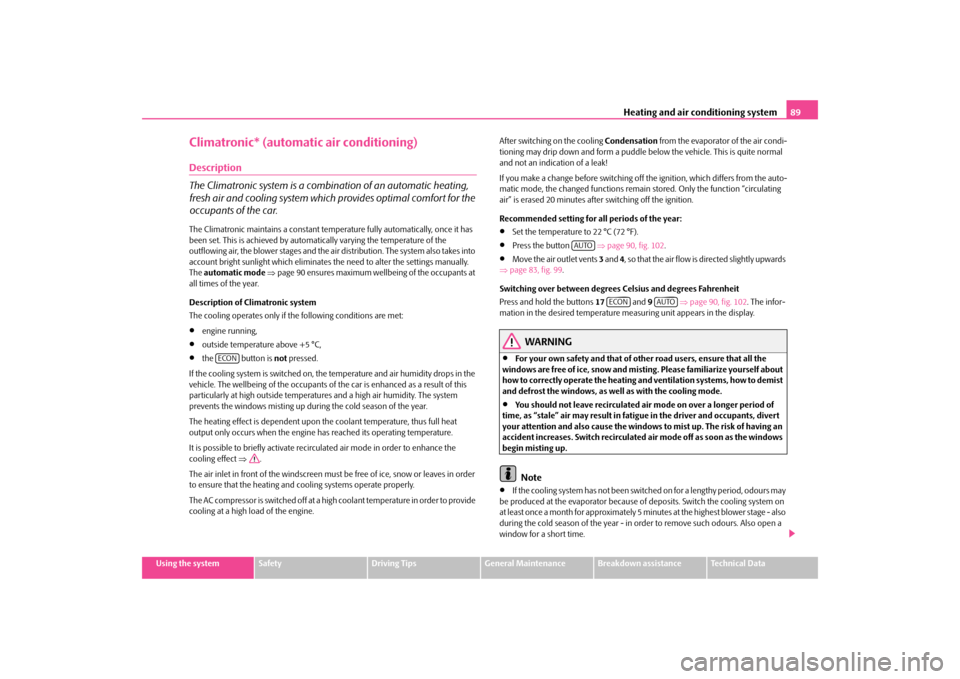
Heating and air conditioning system
89
Using the system
Safety
Driving Tips
General Maintenance
Breakdown assistance
Technical Data
Climatronic* (automatic air conditioning)Description The Climatronic system is a combin
ation of an automatic heating,
fresh air and cooling system which provides optimal comfort for the occupants of the car.The Climatronic maintains a constant temp
erature fully automatically, once it has
been set. This is achiev
ed by automatically varying the temperature of the
outflowing air, the blower stages and the ai
r distribution. The system also takes into
account bright sunlight which eliminates
the need to alter the settings manually.
The
automatic mode
⇒page 90 ensures maximum wellbeing of the occupants at
all times of the year. Description of Climatronic system The cooling operates only if the following conditions are met:•
engine running,
•
outside temperature above +5 °C,
•
the button is
not
pressed.
If the cooling system is switched on, the temperature and air humidity drops in the vehicle. The wellbeing of the occupants of
the car is enhanced as a result of this
particularly at high outs
ide temperatures and a high air humidity. The system
prevents the windows misting up during the cold season of the year. The heating effect is dependent upon th
e coolant temperature, thus full heat
output only occurs when the engine has reached its operating temperature. It is possible to briefly activate recirc
ulated air mode in order to enhance the
cooling effect
⇒
.
The air inlet in front of the windscreen must be free of ice, snow or leaves in order to ensure that the heating and cooling systems operate properly. The AC compressor is switched off at a hi
gh coolant temperature in order to provide
cooling at a high load of the engine.
After switching on the cooling
Condensation
from the evaporator of the air condi-
tioning may drip down and form a puddle be
low the vehicle. This is quite normal
and not an indication of a leak! If you make a change before switching off
the ignition, which differs from the auto-
matic mode, the changed functions remain
stored. Only the function “circulating
air” is erased 20 minutes after switching off the ignition. Recommended setting for all periods of the year:•
Set the temperature to 22 °C (72 °F).
•
Press the button
⇒page 90, fig. 102
.
•
Move the air outlet vents
3 and
4, s o t h a t th e a i r f l o w i s d i re c t e d s l i g h tl y u pw a rd s
⇒ page 83, fig. 99
.
Switching over between degrees
Celsius and degrees Fahrenheit
Press and hold the buttons
17 and
9
⇒page 90, fig. 102
. The infor-
mation in the desired temperature measuring unit appears in the display.
WARNING
•
For your own safety and that of other road users, ensure that all the
windows are free of ice, snow and mistin
g. Please familiarize yourself about
how to correctly operate th
e heating and ventilation systems, how to demist
and defrost the windows, as well as with the cooling mode.•
You should not leave recirculated air mode on over a longer period of
time, as “stale” air may result in fatigue in the driver and occupants, divert your attention and also cause the windows to mist up. The risk of having an accident increases. Switch recirculated air mode off as soon as the windows begin misting up.
Note
•
If the cooling system has not been switched on for a lengthy period, odours may
be produced at the evaporator because of
deposits. Switch the cooling system on
at least once a month for approximately 5 mi
nutes at the highest blower stage - also
during the cold season of the year - in
order to remove such odours. Also open a
window for a short time.
ECON
AUTO
ECON
AUTO
s2g8.b.book Page 89 Tuesday, April 7, 2009 8:53 AM
Page 133 of 224
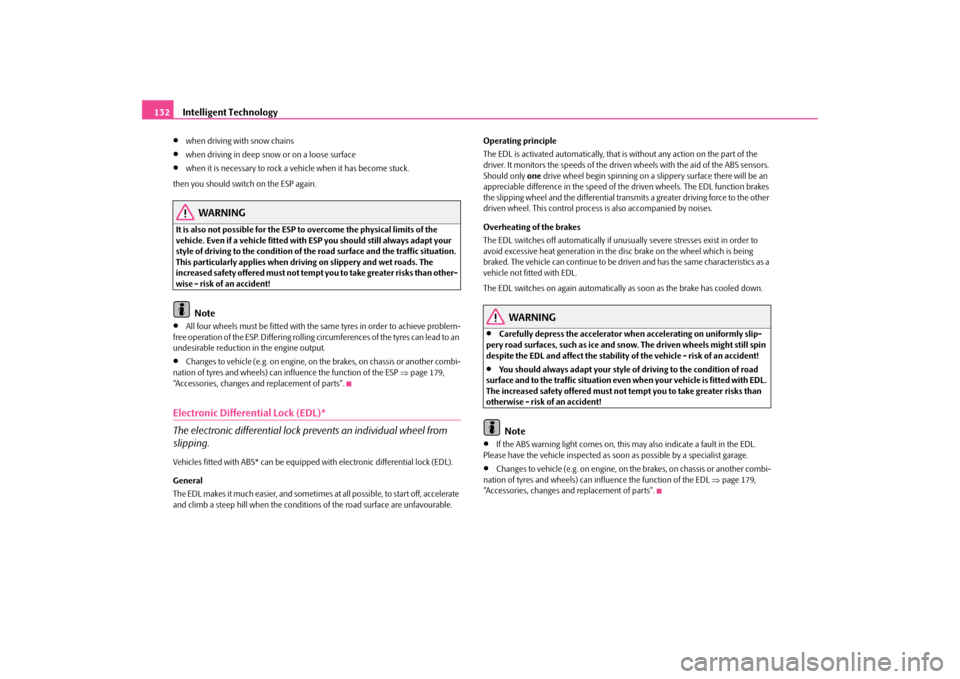
Intelligent Technology
132
•
when driving with snow chains
•
when driving in deep snow or on a loose surface
•
when it is necessary to rock a vehicle when it has become stuck.
then you should switch on the ESP again.
WARNING
It is also not possible for the ESP to overcome the physical limits of the vehicle. Even if a vehicle fitted with ESP you should still always adapt your style of driving to the condition of the
road surface and the traffic situation.
This particularly applies when driving on slippery and wet roads. The increased safety offered must not tempt you to take greater risks than other- wise - risk of an accident!
Note
•
All four wheels must be fitted with the same tyres in order to achieve problem-
free operation of the ESP. Differing rolling
circumferences of the tyres can lead to an
undesirable reduction in the engine output.•
Changes to vehicle (e.g. on engine, on the brakes, on chassis or another combi-
nation of tyres and wheels) can influence the function of the ESP
⇒page 179,
“Accessories, changes and replacement of parts”.Electronic Differential Lock (EDL)* The electronic differential lock pr
events an individual wheel from
slipping.Vehicles fitted with ABS*
can be equipped with electron
ic differential lock (EDL).
General The EDL makes it much easier, and sometimes at all possible, to start off, accelerate and climb a steep hill when the conditio
ns of the road surface are unfavourable.
Operating principle The EDL is activated automatically, that is
without any action on the part of the
driver. It monitors the speeds of the driven wheels with the aid of the ABS sensors. Should only
one
drive wheel begin spinning on a slippery surface there will be an
appreciable difference in the speed of the driven wheels. The EDL function brakes the slipping wheel and the differential transmits a greater driving force to the other driven wheel. This control proces
s is also accompanied by noises.
Overheating of the brakes The EDL switches off
automatically if unusually severe
stresses exist in order to
avoid excessive heat generation in the
disc brake on the wheel which is being
braked. The vehicle can continue to be driv
en and has the same characteristics as a
vehicle not fitted with EDL. The EDL switches on again
automatically as soon as the brake has cooled down.
WARNING
•
Carefully depress the accelerator when accelerating on uniformly slip-
pery road surfaces, such as ice and sn
ow. The driven wheels might still spin
despite the EDL and affect the stability
of the vehicle - risk of an accident!
•
You should always adapt your style of driving to the condition of road
surface and to the traffic situation even
when your vehicle is fitted with EDL.
The increased safety offered must not tempt you to take greater risks than otherwise - risk of an accident!
Note
•
If the ABS warning light comes on, this ma
y also indicate a fault in the EDL.
Please have the vehicle inspected as soon
as possible by a specialist garage.
•
Changes to vehicle (e.g. on engine, on the brakes, on chassis or another combi-
nation of tyres and wheels) can in
fluence the function of the EDL
⇒page 179,
“Accessories, changes and
replacement of parts”.
s2g8.b.book Page 132 Tuesday, April 7, 2009 8:53 AM
Page 134 of 224

Intelligent Technology
133
Using the system
Safety
Driving Tips
General Maintenance
Breakdown assistance
Technical Data
Traction control system (TCS) The traction control system prevents
the driven wheels from spinning
when accelerating.General The TCS makes it much easier, and sometimes at all possible, to start off, accelerate and climb a steep hill when the conditio
ns of the road surface are unfavourable.
Operating principle The TCS switches on automatically when th
e engine is started and then conducts a
self-test. The system monitors the speeds of the driven wheels with the aid of the ABS sensors. If the wheels are spinning, the force transmitted to the road surface is automatically adapted by redu
cing the engine speed. Th
is occurs at all speeds.
The TCS operates in combination with the ABS
⇒page 135, “Antilock brake system
(ABS)*”. The TCS will not function if a fault exists in the ABS system. The TCS warning light
⇒page 33 lights up in the instrument cluster when there is a
fault on the TCS. Switching off You can switch the TCS off and on again
as you wish by pressing the button
⇒ fig. 140
. The TCS warning light
⇒page 33 lights up in the instrument cluster
when the TCS is switched off.
The TCS should normally always be switched on. It may be good practice in certain exceptional cases, such as when you wish
to have wheel slip, to switch off the
system. Examples:•
when driving with snow chains
•
when driving in deep snow or on a loose surface
•
when it is necessary to rock a vehicle when it has become stuck.
then you should switch on the TCS again.
WARNING
You should always adjust your style of driving to the conditions of the road surface and the traffic situation. The increased safety offered must not tempt you to take greater risks than otherwise - risk of an accident!
Note
•
All four wheels must be fitted with the same tyres in order to achieve problem-
free operation of the TCS. Differing rolling circumferences of the tyres can lead to an undesirable reduction in the engine output.•
Changes to vehicle (e.g. on engine, on
the brakes, on chassis or another combi-
nation of tyres and wheels) can in
fluence the function of the TCS
⇒page 179,
“Accessories, changes and replacement of parts”.BrakesWhat has a negative effect on braking efficiency?Wear-and-tear Wear-and-tear to the brake pads is greatly dependent on the operating conditions of the vehicle and your style of driving. Particularly if you drive a great deal in towns and over short distances or if you adopt a sporty style of driving, it may be neces- sary to have the thickness of the brake
pads inspected at a specialist garage
between the service inspections.
Fig. 140 TCS switch
s2g8.b.book Page 133 Tuesday, April 7, 2009 8:53 AM
Page 136 of 224

Intelligent Technology
135
Using the system
Safety
Driving Tips
General Maintenance
Breakdown assistance
Technical Data
Antilock brake system (ABS)*ABS prevents the wheels locking when braking.General The ABS contributes significan
tly to enhancing the active
safety of your vehicle.
Compared to a vehicle not fitted with the ABS brake system, you are able to retain optimal steering ability even during a fu
ll brake application on a slippery road
surface because the wheels do not lock up. You must not expect, however, that the br
aking distance will be shorter under all
circumstances as a result of the ABS. Th
e braking distance for example on gravel
and fresh snow, when you should anyway be driving slowly and cautiously, will be longer. Operating principle The brake pressure will be reduced on a wheel which is rotating at a speed which is too low for the speed of the vehicle and tend
ing to lock. This control cycle is notice-
able from a
pulsating movement of the brake pedal
which is accompanied by
noises. This is consciously intended to provide the driver with the information that the wheels are tending to lock (ABS control range). You must always keep the brake pedal depressed to enable the ABS to optima
lly control the brake application in this
braking range. Never interrupt the application of the brakes!
WARNING
•
The ABS can also not overcome the physic
al limits of your
vehicle. Please
do not forget this, particularly when driv
ing on icy or wet road surfaces. If the
ABS is operating within the control ra
nge, adapt your speed immediately to
the conditions of the road surface an
d the traffic situation. The increased
safety offered by the ABS must not tempt you to take greater risks than otherwise - risk of an accident!•
The normal braking system is
still fully functional if there is an ABS fault.
Visit a specialist garage as
quickly as possible and adju
st your style of driving
to take account of the ABS fault in the meantime since you will not know the extent of the fault and in how far
the braking efficiency is affected.
Note
•
A warning light comes on if a fault occurs in the ABS system
⇒page 32.
•
Changes to vehicle (e.g. on engine, on
the brakes, on chassis or another combi-
nation of tyres and wheels) can in
fluence the function of the ABS
⇒page 179,
“Accessories, changes and replacement of parts”.Brake Assist*During a severe brake application (e.g. if a hazard exists), the Brake Assist increases the braking force and thus makes it possible to rapidly produce the pressure required in the brake system. The majority of drivers do apply the brakes in good time in dangerous situations, but do not depress the brake pedal with suff
icient pressure. Consequently, it is not
possible for the vehicle to achieve its maximum deceleration and the vehicle covers a greater distance than necessary. The Brake Assist is activated by the very quick operation of the brake pedal. In such cases, a much greater braking pressure ex
ists than during a
normal brake applica-
tion. This makes it possible, even with a relatively low resistance of the brake pedal, to produce an adequate pressure in the brake system in the shortest possible time, which is required for maximum decelerati
on of the vehicle. You must apply the
brake pedal firmly and
hold it in this position in order to achieve the shortest
possible braking distance. The Brake Assist is able to help you achi
eve a shorter braking distance in emergency
situations by rapidly producing the pressure
required in the brake system. It fully
exploits the attributes of the ABS. After yo
u release the brake peda
l, the function of
the Brake Assist is automatically switched off and the brakes operate in the normal way.
WARNING
•
The Brake Assist is also not able to overcome the physical limits of your
vehicle in terms of the br
aking distance required.
s2g8.b.book Page 135 Tuesday, April 7, 2009 8:53 AM
Page 143 of 224
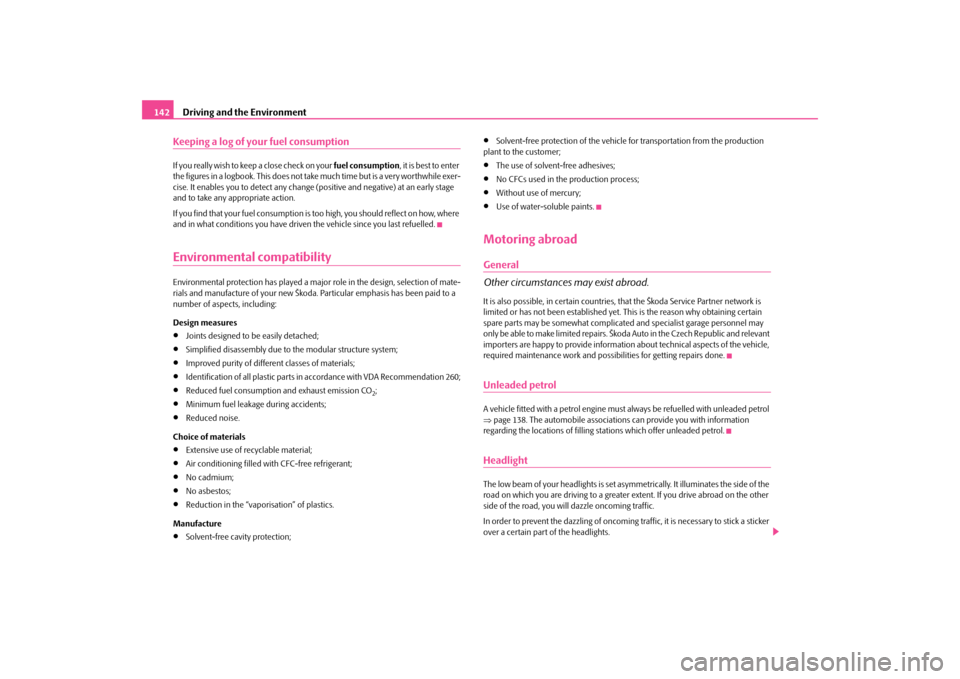
Driving and the Environment
142
Keeping a log of your fuel consumptionIf you really wish to ke
ep a close check on your
fuel consumption
, it is best to enter
the figures in a logbook. This does not take
much time but is a very worthwhile exer-
cise. It enables you to detect any change
(positive and negative) at an early stage
and to take any appropriate action. If you find that your fuel
consumption is too high, you sh
ould reflect on how, where
and in what conditions you have driven
the vehicle since you last refuelled.
Environmental compatibilityEnvironmental protection has played a majo
r role in the design, selection of mate-
rials and manufacture of your new Škoda.
Particular emphasis
has been paid to a
number of aspects, including: Design measures•
Joints designed to
be easily detached;
•
Simplified disassembly due to the modular structure system;
•
Improved purity of differ
ent classes of materials;
•
Identification of all plastic parts in
accordance with VDA Recommendation 260;
•
Reduced fuel consumption
and exhaust emission CO
2;
•
Minimum fuel leakage during accidents;
•
Reduced noise.
Choice of materials•
Extensive use of recyclable material;
•
Air conditioning filled wi
th CFC-free refrigerant;
•
No cadmium;
•
No asbestos;
•
Reduction in the “vaporisation” of plastics.
Manufacture•
Solvent-free cavity protection;
•
Solvent-free protection of the vehicle for transportation from the production
plant to the customer;•
The use of solvent-free adhesives;
•
No CFCs used in the production process;
•
Without use of mercury;
•
Use of water-soluble paints.
Motoring abroadGeneral Other circumstances may exist abroad.It is also possible, in certain countries, that the Škoda Service Partner network is limited or has not been established yet.
This is the reason why obtaining certain
spare parts may be somewhat complicate
d and specialist garage personnel may
o n l y b e a b l e t o m a ke l i m i te d re p a i rs . Š ko d a A u to i n t h e C z e c h R e pu b l i c a n d re l e v a n t importers are happy to provide information
about technical aspects of the vehicle,
required maintenance work and possibilities for getting repairs done.Unleaded petrolA vehicle fitted with a petrol engine must always be refuelled with unleaded petrol ⇒ page 138. The automobile associations can provide you with information regarding the locations of filling stations which offer unleaded petrol.HeadlightThe low beam of your headlights is set asym
metrically. It illuminates the side of the
road on which you are driving to a greater
extent. If you drive abroad on the other
side of the road, you wi
ll dazzle oncoming traffic.
In order to prevent the dazzling of oncoming traffic, it is necessary to stick a sticker over a certain part of the headlights.
s2g8.b.book Page 142 Tuesday, April 7, 2009 8:53 AM
Page 154 of 224
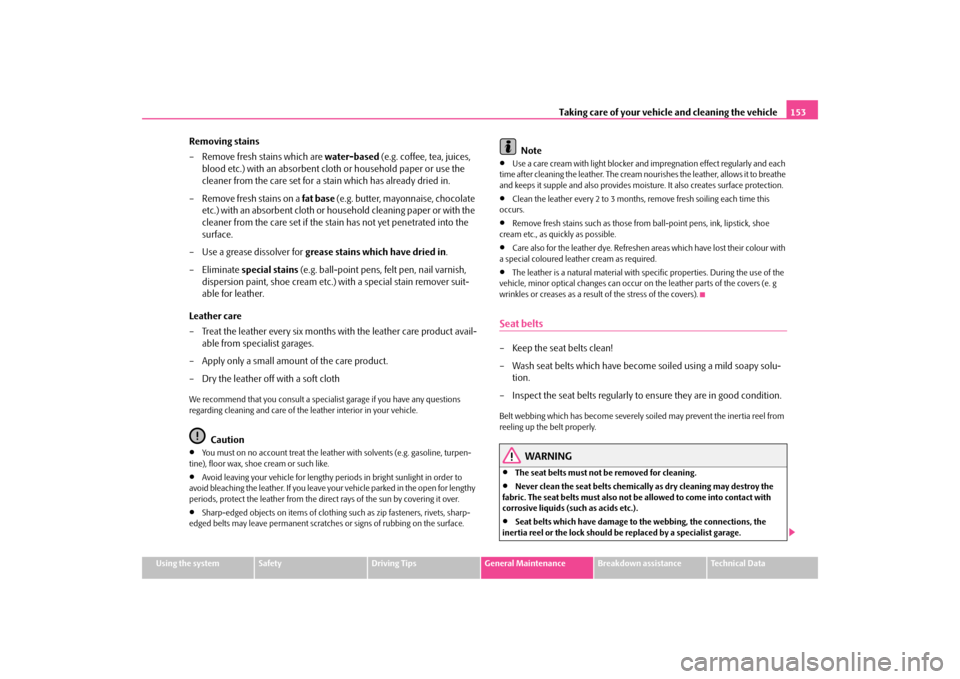
Taking care of your vehicle and cleaning the vehicle
153
Using the system
Safety
Driving Tips
General Maintenance
Breakdown assistance
Technical Data
Removing stains – Remove fresh stains which are
water-based
(e.g. coffee, tea, juices,
blood etc.) with an absorbent cloth or household paper or use the cleaner from the care set for a
stain which has already dried in.
– Remove fresh stains on a
fat base
(e.g. butter, mayonnaise, chocolate
etc.) with an absorbent cloth or household cleaning paper or with the cleaner from the care set if the stain has not yet penetrated into the surface.
– Use a grease dissolver for
grease stains which have dried in
.
–Eliminate
special stains
(e.g. ball-point pens, felt pen, nail varnish,
dispersion paint, shoe cream etc.) with a special stain remover suit-able for leather.
Leather care – Treat the leather every six months with the leather care product avail-
able from specialist garages.
– Apply only a small amount of the care product.– Dry the leather off with a soft clothWe recommend that you consult a speciali
st garage if you have any questions
regarding cleaning and care of the
leather interior in your vehicle.
Caution
•
You must on no account treat the leather with solvents (e.g. gasoline, turpen-
tine), floor wax, shoe cream or such like.•
Avoid leaving your vehicle for lengthy pe
riods in bright sunlight in order to
avoid bleaching the leather. If
you leave your vehicle parked in the open for lengthy
periods, protect the leather from the direct
rays of the sun by covering it over.
•
Sharp-edged objects on items of clothing
such as zip fasteners, rivets, sharp-
edged belts may leave permanent scratche
s or signs of rubbing on the surface.
Note
•
Use a care cream with light blocker and impregnation effect regularly and each
time after cleaning the leather. The cream no
urishes the leather, allows it to breathe
and keeps it supple and also provides moisture. It also creates surface protection.•
Clean the leather every 2 to 3 months, remove fresh soiling each time this
occurs.•
Remove fresh stains such as those from
ball-point pens, ink, lipstick, shoe
cream etc., as quickly as possible.•
Care also for the leather dye. Refreshen
areas which have lost their colour with
a special coloured leather cream as required.•
The leather is a natural material with specific properties. During the use of the
vehicle, minor optical change
s can occur on the leather parts of the covers (e. g
wrinkles or creases as a result of the stress of the covers).Seat belts– Keep the seat belts clean! – Wash seat belts which have become
soiled using a mild soapy solu-
tion.
– Inspect the seat belts regularly to
ensure they are in good condition.
Belt webbing which has become severely so
iled may prevent the inertia reel from
reeling up the belt properly.
WARNING
•
The seat belts must not be removed for cleaning.
•
Never clean the seat belts chemically
as dry cleaning may destroy the
fabric. The seat belts must also not be allowed to come into contact with corrosive liquids (such as acids etc.).•
Seat belts which have damage to
the webbing, the connections, the
inertia reel or the lock should be
replaced by a specialist garage.
s2g8.b.book Page 153 Tuesday, April 7, 2009 8:53 AM
Page 163 of 224
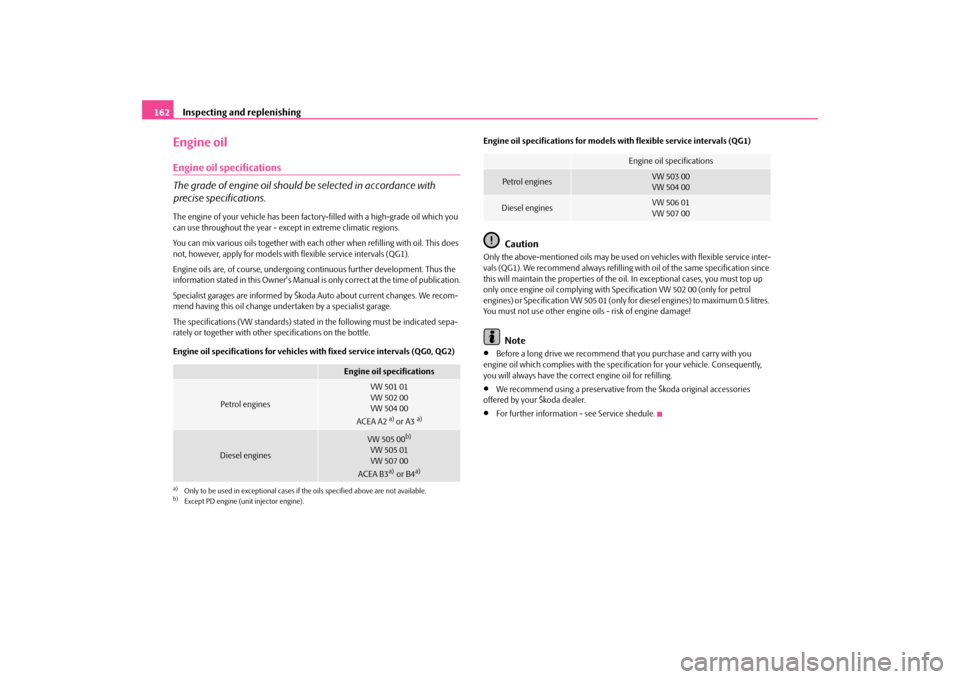
Inspecting and replenishing
162
Engine oilEngine oil specifications The grade of engine oil should be selected in accordance with precise specifications.The engine of your vehicle has been fact
ory-filled with a high-grade oil which you
can use throughout the year - exce
pt in extreme climatic regions.
You can mix various oils together with each other when refilling with oil. This does not, however, apply for models with
flexible service intervals (QG1).
Engine oils are, of course, undergoing co
ntinuous further deve
lopment. Thus the
information stated in this Owner's Manual is only correct at the time of publication. Specialist garages are informed by Škoda Auto about current changes. We recom- mend having this oil change und
ertaken by a specialist garage.
The specifications (VW standards) stated in the following must be indicated sepa- rately or together with other specifications on the bottle. Engine oil specifications for vehicles with fixed service intervals (QG0, QG2)
Engine oil specifications for models with flexible service intervals (QG1)
Caution
Only the above-mentioned oils may be used on vehicles with flexible service inter- vals (QG1). We recommend always refilling with oil of the same specification since this will maintain the properties of the oi
l. In exceptional cases, you must top up
only once engine oil complying with Specification VW 502 00 (only for petrol engines) or Specification VW 505 01 (only for diesel engines) to maximum 0.5 litres. You must not use other engine oi
ls - risk of engine damage!
Note
•
Before a long drive we recommend th
at you purchase and carry with you
engine oil which complies with the specif
ication for your vehi
cle. Consequently,
you will always have the corr
ect engine oil for refilling.
•
We recommend using a preservative fr
om the Škoda original accessories
offered by your Škoda dealer.•
For further information - see Service shedule.
Engine oil specifications
Petrol engines
VW 501 01 VW 502 00 VW 504 00
ACEA A2
a) or A3
a)
a)Only to be used in exceptional cases if
the oils specified above are not available.
Diesel engines
VW 505 00
b)
VW 505 01 VW 507 00
ACEA B3
a) or B4
a)
b)Except PD engine (unit injector engine).
Engine oil specifications
Petrol engines
VW 503 00 VW 504 00
Diesel engines
VW 506 01 VW 507 00
s2g8.b.book Page 162 Tuesday, April 7, 2009 8:53 AM
Page 171 of 224
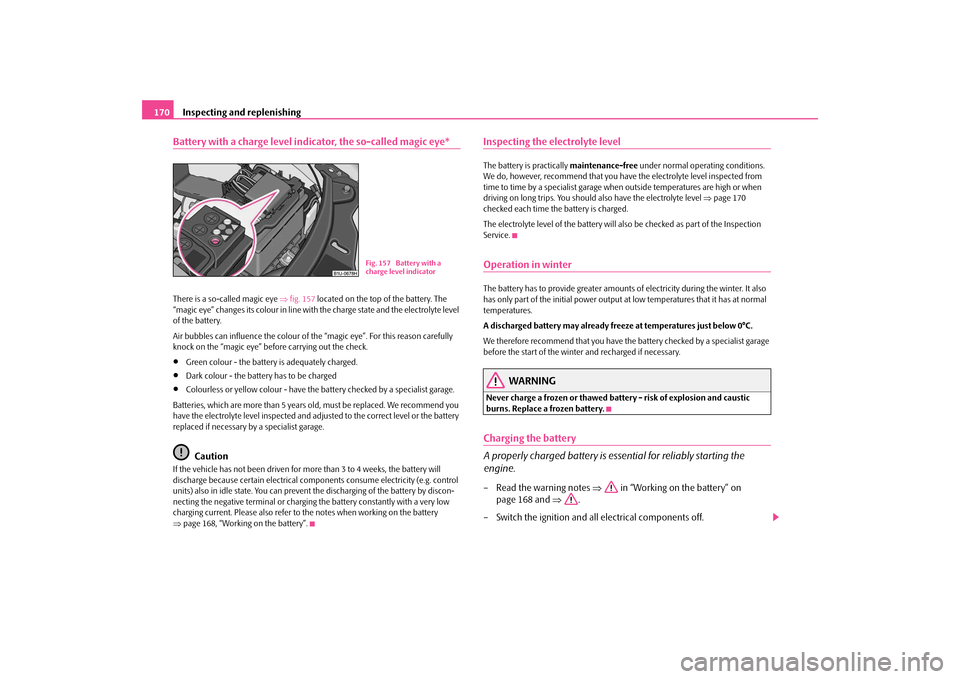
Inspecting and replenishing
170
Battery with a charge level indicator, the so-called magic eye*There is a so-called magic eye
⇒fig. 157
located on the top of the battery. The
“magic eye” changes its colour in line with the charge state and the electrolyte level of the battery. Air bubbles can influence the colour of th
e “magic eye”. For this reason carefully
knock on the “magic eye” before carrying out the check.•
Green colour - the battery is adequately charged.
•
Dark colour - the battery has to be charged
•
Colourless or yellow colour - have the battery checked by a specialist garage.
Batteries, which are more than 5 years old, must be replaced. We recommend you have the electrolyte level inspected and adjusted to the correct level or the battery replaced if necessary by
a specialist garage.
Caution
If the vehicle has not been driven for more than 3 to 4 weeks, the battery will discharge because certain electrical comp
onents consume electricity (e.g. control
units) also in idle state. You can prevent
the discharging of the battery by discon-
necting the negative terminal or charging
the battery constantly with a very low
charging current. Please also refer to
the notes when working on the battery
⇒ page 168, “Working on the battery”.
Inspecting the electrolyte levelThe battery is practically
maintenance-free
under normal operating conditions.
We do, however, recommend that you have
the electrolyte level inspected from
time to time by a specialist garage when outside temperatures are high or when driving on long trips. You should also have the electrolyte level
⇒page 170
checked each time the battery is charged. The electrolyte level of the battery will al
so be checked as part of the Inspection
Service.Operation in winterThe battery has to provide greater amounts of electricity during the winter. It also has only part of the initial power output at
low temperatures that it has at normal
temperatures. A discharged battery may already freez
e at temperatures just below 0°C.
We therefore recommend that you have the battery checked by a specialist garage before the start of the winter and recharged if necessary.
WARNING
Never charge a frozen or thawed battery - risk of explosion and caustic burns. Replace a frozen battery.Charging the battery A properly charged battery is essential for reliably starting the engine.– Read the warning notes
⇒
in “Working on the battery” on
page 168 and
⇒
.
– Switch the ignition and all electrical components off.
Fig. 157 Battery with a charge level indicator
s2g8.b.book Page 170 Tuesday, April 7, 2009 8:53 AM
Page 180 of 224
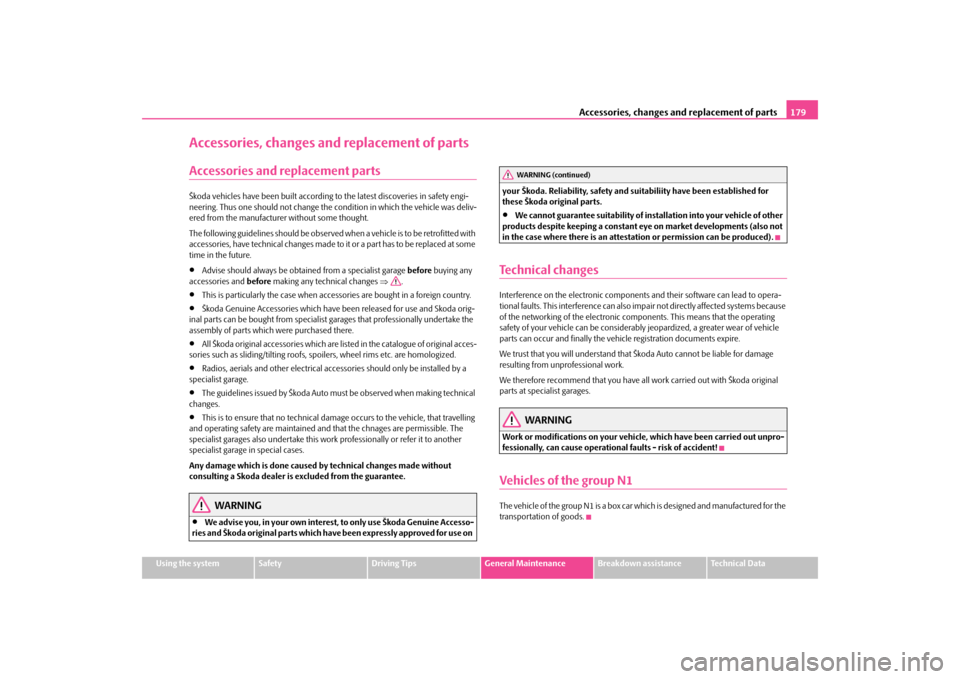
Accessories, changes and
replacement of parts
179
Using the system
Safety
Driving Tips
General Maintenance
Breakdown assistance
Technical Data
Accessories, changes and replacement of partsAccessories and replacement partsŠkoda vehicles have been bu
ilt according to the latest discoveries in safety engi-
neering. Thus one should no
t change the condition in which the vehicle was deliv-
ered from the manufacturer without some thought. The following guidelines should be observed when a vehicle is to be retrofitted with accessories, have technical ch
anges made to it or a par t has to be replaced at some
time in the future.•
Advise should always be obtained from a specialist garage
before
buying any
accessories and
before
making any technical changes
⇒
.
•
This is particularly the case when acce
ssories are bought in a foreign country.
•
Škoda Genuine Accessories which have b
een released for use and Skoda orig-
inal parts can be bought from specialist
garages that professionally undertake the
assembly of parts which were purchased there.•
All Škoda original accessories which are listed in the catalogue of original acces-
sories such as sliding/tilting roofs, sp
oilers, wheel rims et
c. are homologized.
•
Radios, aerials and other electrical acce
ssories should only be installed by a
specialist garage.•
The guidelines issued by Škoda Auto must be observed when making technical
changes.•
This is to ensure that no technical damage
occurs to the vehicle, that travelling
and operating safety are maintained and that the chnages are permissible. The specialist garages also undertake this work professionally or refer it to another specialist garage in special cases. Any damage which is done caused by technical changes made without consulting a Skoda dealer is
excluded from the guarantee.
WARNING
•
We advise you, in your own interest, to only use Škoda Genuine Accesso-
ries and Škoda original parts which have
been expressly approved for use on
your Škoda. Reliability, safety and su
itabiliity have been established for
these Škoda original parts.•
We cannot guarantee suitability of installation into your vehicle of other
products despite keeping a constant ey
e on market developments (also not
in the case where there is an attestation or permission can be produced).Technical changesInterference on the electronic components and their software can lead to opera-tional faults. This interference can also impair not directly affected systems because of the networking of the electronic co
mponents. This means that the operating
safety of your vehicle can
be considerably jeopardized,
a greater wear of vehicle
parts can occur and finally the vehi
cle registration documents expire.
We trust that you will understand that
Škoda Auto cannot be liable for damage
resulting from unprofessional work. We therefore recommend that you have all work carried out with Škoda original parts at specialist garages.
WARNING
Work or modifications on your vehicle, which have been carried out unpro-fessionally, can cause operational faults - risk of accident!Vehicles of the group N1The vehicle of the group N1 is a box car wh
ich is designed and manufactured for the
transportation of goods.
WARNING (continued)
s2g8.b.book Page 179 Tuesday, April 7, 2009 8:53 AM
Page 203 of 224
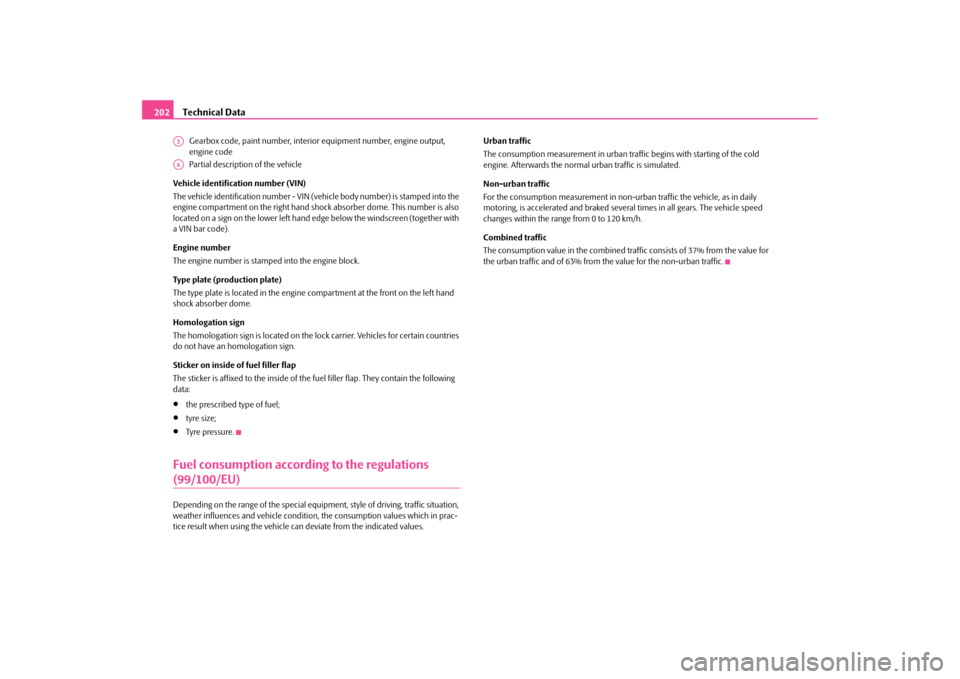
Technical Data
202
Gearbox code, paint number, interior
equipment number, engine output,
engine code Partial description of the vehicle
Vehicle identification number (VIN) The vehicle identification num
ber - VIN (vehicle body number) is stamped into the
engine compartment on the right hand shoc
k absorber dome. This number is also
located on a sign on the lower left hand
edge below the windscreen (together with
a VIN bar code). Engine number The engine number is stamped into the engine block. Type plate (production plate) The type plate is located in the engine co
mpartment at the front on the left hand
shock absorber dome. Homologation sign The homologation sign is located on the lo
ck carrier. Vehicles for certain countries
do not have an homologation sign. Sticker on inside of fuel filler flap The sticker is affixed to the inside of the fuel filler flap. They contain the following data:•
the prescribed type of fuel;
•
tyre size;
•
Tyre pressure.
Fuel consumption according to the regulations (99/100/EU)Depending on the range of the special equipment, style of driving, traffic situation, weather influences an
d vehicle condition, the consum
ption values which in prac-
tice result when using the vehicle ca
n deviate from the indicated values.
Urban traffic The consumption measurement in urban traf
fic begins with starting of the cold
engine. Afterwards the normal
urban traffic is simulated.
Non-urban traffic For the consumption measurement in non-ur
ban traffic the vehicle, as in daily
motoring, is accelerated and braked several times in all gears. The vehicle speed changes within the range from 0 to 120 km/h. Combined traffic The consumption value in the combined traf
fic consists of 37%
from the value for
the urban traffic and of 63% from
the value for the non-urban traffic.
A3A4s2g8.b.book Page 202 Tuesday, April 7, 2009 8:53 AM